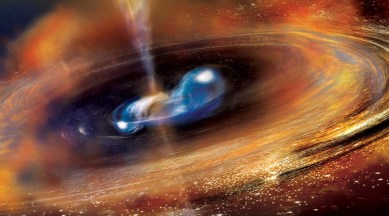A binary merger just outside our Milky Way links long GRB with kilonovae
GRBs are massive but extremely bright, high-energy short gamma radiations which get released when massive stars collapse or die in the Universe.

In a first-of-its-kind detection, a team of astronomers has recorded a rare astronomical event involving a compact binary merger emitting long Gamma Ray Burst (GRB) twinned with a kilonova emissions — a never before scientifically accepted or proven combination.
What made the burst of high energy light identified as GRB211211A on December 11, 2021, that lasted for over 50 seconds unique was because it unfolded nearby, that is, in the outskirts of our Milky Way at some one billion light years away. Moreover, the typical long duration GRB features were missing; its features deviated from the standard non-thermal power law — all of these making the event a rarity.
GRBs are massive but extremely bright, high-energy short gamma radiations which get released when massive stars collapse or die in the Universe. In fact, the energy associated with GRBs is many folds larger than what our Sun can emit in its entire lifetime, making its study key to understanding the life and death of stars in our Universe.
When a pair of binary compact systems — either two blackholes, dense celestial bodies or neutron stars — rotate in a spiral fashion for billions of years, their ultimate merger leads to release of short GRBs. These emissions last for less than two seconds. And traditionally, kilonova — the radiations emerging from the merger of neutron stars or any binary system — has been associated with short GRBs.
On the other hand, when very massive stars die, the event results in the release of long GRBs and the associated gamma radiations last for more than two seconds or longer. And scientists have, so far, associated short GRBs with supernovae.
That is why, the latest study published in Nature on Wednesday, has quashed the existing understanding for at least 30 years now, as scientists were unaware of any connection between a long duration GRB and kilnovae.
“But the after-glow properties of this event clearly lean towards kilonova. This could then mean that some processes are common between the long and short GRBs. The new study results clearly indicate that our classification of long and short GRBs now stands challenged,” said Shashi Bhushan Pandey, Principal Investigator of the DOT and one of the authors of the paper.
This international collaborative study included researchers from Arizona State University, Los Alamos National Laboratory, University of Rome, University of Maryland, The George Washington University, NASA Goddard Space Flight Centre, Permiter Institute of Theoretical Physics, Canada, The Pennsylvania State University, Pandit Ravishakar Shukla University, Tokyo Institute of Technology, Deen Dayal Upadhyay Gorakhpur University, Boise State University, University of Bath, Unidad Asociada al CSIS and Instituto de Astrofisica de Andalucia in Spain. They used follow-up observations of the event using some of the most advanced instruments like the Hubble Space Telescope, Multicolour Imaging Telescopes for Survey and Monstrous Explosions (MITSuME), Japan and Color Alto Observatory in Spain.
“DOT located in Nainital enjoys the longitudinal advantage which facilitated the viewing of the event. If there was no 3.6 metre optical telescope available, we could not have detected the event from here as well. To study more such events, we will need to build more sensitive instruments,” added Pandey.